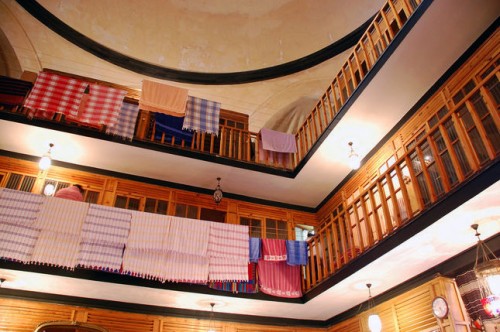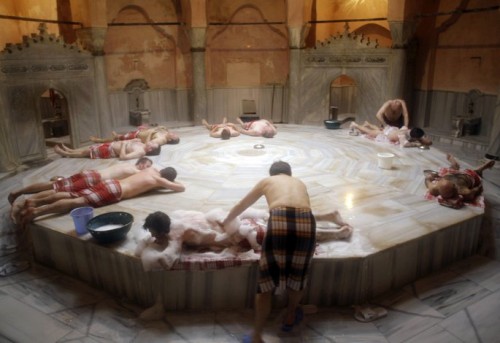I bought my ticket, a yellow plastic tab, and was given a small cardboard box. A cluster of topless Turkish men in plaid towels gestured toward one of the narrow staircases. I climbed to the second level balcony where I was ushered into a wooden cubicle. I stripped down, wrapped a towel around my waist and stepped into some plastic sandals. The attendant asked for the yellow tab, then locked the room and handed me the key.
Clutching the cardboard box and key, I went back down the stairs to the lobby, where my burly masseur, Ahmet, met me and shook my hand. After a quiz to determine my correct nationality, he led me into the cooling-down room. He removed a small scrub mitt from the box, handed it to me and pointed to the interior of the empty box. For a moment I thought he was about to do a conjuring trick, but then he pointed inside the box again, rubbed his thumb and forefinger together and said the word “token”. I pantomimed that all I had was a mitt, key and towel. No hidden lira or euros. He rolled his eyes, slapped me manfully on the shoulder and said: “later!”
Pointing toward the edge of the huge marble platform beneath the hot room dome, Ahmet guided me to lay on my back with my head on a small spittoon-like metal headrest, and then left me to sweat for fifteen minutes. The heat and humidity from the platform was intense, eventually almost hallucinatory as I stared upward at the terracotta dome perforated by round holes. Every few seconds, a drum-like boom seemed to come from deep inside the walls.
Ahmet returned and started splashing me with buckets of hot water, had me sit up, roll over, stand and lie down again. Next I could feel a softness glide over me and looked down to see soapsuds drifting upward over my shoulders and neck. Ahmet began to scrub me all over, in different positions, stopping to point out an accumulation of dead skin on one of my arms. I was doused with hot water again, massaged, taken into the cool-down room where he washed and kneaded my head.
Ahmet splashed me with cold water and returned me to the hot room. Pointing to the marble platform, he gave me terse one and two-word instructions to lie down for no less than ten minute, take a shower, dry off with a towel, go upstairs and dress, come down and give the token there. Not upstairs. Down.
Related Posts
Bruce Charlesworth is an artist, writer and filmmaker. He one of the pioneers of postmodern staged photography and among the first artists to use video and audio to power aspects of physically immersive “narrative environments.” He teaches in the Department of Film/Video/New Genres at the University of Wisconsin Peck School of the Arts in Milwaukee. He previously reported on Ars Electronica in 2009 for Public Address.


